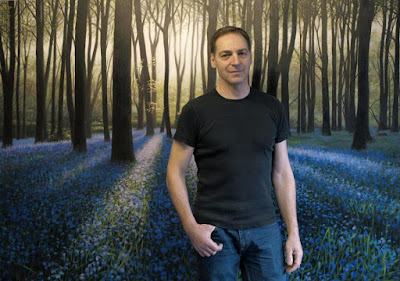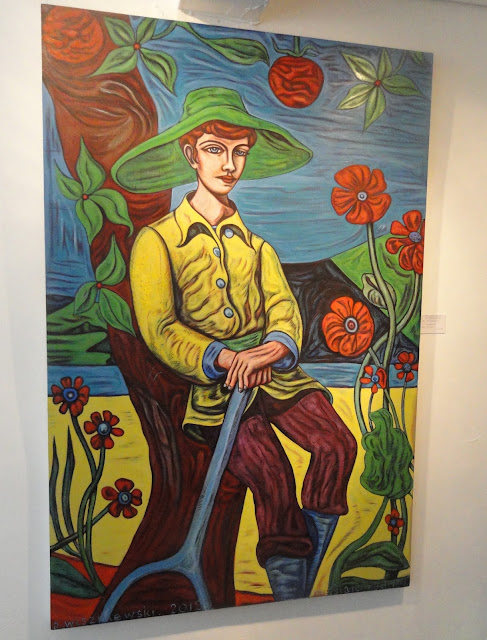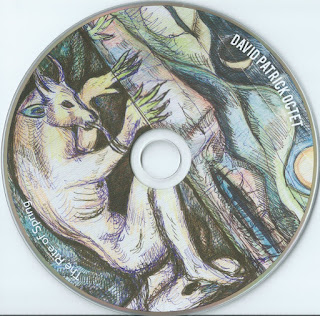DEVILS IN THE MAKING, GoMA, Glasgow
I never thought I would live to see the day!! Glasgow's successful artists actually showing their work in Glasgow's prime civic Gallery of Modern Art. Twenty years ago it looked unlikely. Things in Glasgow had deteriorated into farce. So this is all Better Late Than Never etc .. altho I still have some concerns. Of which more later.
This show of contemporary art includes 21 now well known figures & runs in parallel with the Turner Prize opening at Tramway. It's the first time the prestigious Turner Prize will be held, not in London, but in Scotland. Glasgow is, rightly, showing off its famous artists.
As no less a person that Nick Serota, the Tate's director, says, "Over the last 20 years, Glasgow and Scotland has gained national and international recognition as a centre of excellence in, and for, the visual arts and for many years artists who are from Scotland or who have trained at the Glasgow School of Art – one of the world’s leading art schools – have been nominated for, or won, the Tate Turner award." A great puff for Glasgow.
It was not always so!
In 1996 when the £7m new GoMA opened to the public, Glasgow became a national laughing stock. Heralded as "a mockery, fundamentally flawed & fourth rate, a travesty, an aesthetic and intellectual disaster," the works on show were banal. And despite the international success of many Scottish artists, especially GSA graduates, Glasgow had made a point of totally ignoring them. Perverse. Stupid. "GoMA, an ugly bilious name to match an ugly, bilious collection, a painful guddle of mediocrity" I wrote at the time, angry that with £250,000 a year to spend on art, (quite a sum 20 years ago) no young Scots benefitted & that Glasgow's reputation was - tragically - in the gutter. Later that year Douglas Gordon won the Turner Prize. As I wrote, "The first video artist to win it, the first non-London-based artist to sweep the board, belatedly allowing the London art establishment to acknowledge the vibrancy of the Glasgow scene. So despite officialdom turning its back on Gordon, the rest of Scotland is proud." I also wondered if it was "too late" to change things. Scotland's top artists had already got to be very expensive, - and anyway, who would want to show in Glasgow when Berlin, Paris & New York called?
Later that year Douglas Gordon won the Turner Prize. As I wrote, "The first video artist to win it, the first non-London-based artist to sweep the board, belatedly allowing the London art establishment to acknowledge the vibrancy of the Glasgow scene. So despite officialdom turning its back on Gordon, the rest of Scotland is proud." I also wondered if it was "too late" to change things. Scotland's top artists had already got to be very expensive, - and anyway, who would want to show in Glasgow when Berlin, Paris & New York called? 
Happily it was not quite too late, as this exhibition demonstrates. However I do wonder if, in some instances, the city could not have acquired better pieces. 
Things get off to a good start with Ross Sinclair's terrific neon signs installed across the facade.
The show fills GoMA's difficult ground floor gallery & despite the gilded columns & awkward entrance, looks lively. I was happy to see what a great energy & spirit was present at the opening.
Kenny Hunter's Churchill's Dogs fit well at the entrance, David Shrigley's funny film continues to crack people up - (he's now establishment enough for him to feature amid the Annunciations & angels in NGS Xmas cards! )-
& Jim Lambie's pile of colour soaked chairs together with Alex Frost's mosaic Ryvita packet make quite a statement.
In this huge space, scale is crucial, and here Claire Barclay has the edge with her 2 giant wood cylinders, but a shame the inside tubes etc add nothing to the piece.
One of the more thoughtful pieces is by Nathan Coley who not only examines the Lockerbie Bombing trial evidence but created an exact replica of the witness box complete with microphone.
 This sits alongside eight drawings representing evidence presented during the trial. The trial was held in the Netherlands, but for 36 weeks the small area where the court stood was temporarily legally Scottish. Coley highlights the arbitrary rules that enabled a country to‘appear’ somewhere else + the assumption that a person is telling the truth just because they are sitting in the witness box..
This sits alongside eight drawings representing evidence presented during the trial. The trial was held in the Netherlands, but for 36 weeks the small area where the court stood was temporarily legally Scottish. Coley highlights the arbitrary rules that enabled a country to‘appear’ somewhere else + the assumption that a person is telling the truth just because they are sitting in the witness box..
Coley loaned this work. Unlike most here it does not belong to Glasgow.
Thus Christine Borland is represented by a piece from 1997, the year she was shortlisted for the Turner Prize; Douglas Gordon by a video from 1998; Roddy Buchanan by his brilliant Gobstopper film of kids holding their breath thro the Clyde Tunnel, while Churchill's Dog date from 1995.
It makes u wonder - Has Glasgow bought nothing since? And will this show look old-fashioned when compared to the current Turner Prize exhibits- all sound, politics & collaboration? And with such a boom in installation, film & performance art of the last decade, is Glasgow still behind the curve? And what about the OLDER generation from the 1980s who got missed out from the funded buying spree both times round? What of them?
It makes u wonder - Has Glasgow bought nothing since? And will this show look old-fashioned when compared to the current Turner Prize exhibits- all sound, politics & collaboration? And with such a boom in installation, film & performance art of the last decade, is Glasgow still behind the curve? And what about the OLDER generation from the 1980s who got missed out from the funded buying spree both times round? What of them?

On the journey the unusual powering method created a small amount of water that was collected in a bottle on the bike, & then used to produce a watercolour of a prickly pear cactus, a plant this survives because of its sparing use of water
 On the down side some pieces like Martin Boyce's neon have been seen far too often, there are some unlikely & unlikable pieces, (Nick Evans's white blobs)
On the down side some pieces like Martin Boyce's neon have been seen far too often, there are some unlikely & unlikable pieces, (Nick Evans's white blobs)
and Karla Black's crumpled heap still looks like an old shower curtain.
I could also name a few who are strangely absent. Maybe they were too expensive? Maybe they still didn't want their work in GoMA. Maybe, maybe ...
But, post 1996, what a triumph! Devils they may be. Meanwhile I hope Glasgow continues to support the home team for many years to come.

























